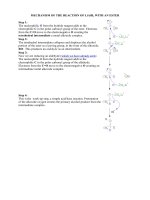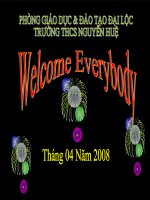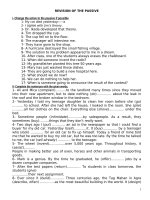biologist wendell stanley of the rockefeller institute purified tobacco mosaic virus (TMV)
Bạn đang xem bản rút gọn của tài liệu. Xem và tải ngay bản đầy đủ của tài liệu tại đây (2.06 MB, 74 trang )
Copyright © by Holt, Rinehart and Winston. All rights reserved.
ResourcesChapter menu
•
To View the presentation as a slideshow with effects
select “View” on the menu bar and click on “Slide Show.”
•
To advance through the presentation, click the right-arrow
key or the space bar.
•
From the resources slide, click on any resource to see a
presentation for that resource.
•
From the Chapter menu screen click on any lesson to go
directly to that lesson’s presentation.
•
You may exit the slide show at any time by pressing
the Esc key.
How to Use This Presentation
Copyright © by Holt, Rinehart and Winston. All rights reserved.
ResourcesChapter menu
Chapter Presentation
Transparencies Standardized Test Prep
Visual Concepts
Resources
Copyright © by Holt, Rinehart and Winston. All rights reserved.
ResourcesChapter menu
Viruses and Bacteria
Chapter 20
Table of Contents
Section 1 Viruses
Section 2 Bacteria
Copyright © by Holt, Rinehart and Winston. All rights reserved.
ResourcesChapter menu
Section 1 Viruses
Objectives
•
Describe why a virus is not considered a living
organism.
•
Summarize the discovery of the tobacco mosaic
virus.
•
Describe the basic structure of a virus.
•
Summarize the steps of viral replication.
•
Explain how HIV infects immune system cells.
Chapter 20
Copyright © by Holt, Rinehart and Winston. All rights reserved.
ResourcesChapter menu
Is a Virus Alive?
•
All living things are made of cells, are able to grow
and reproduce, and are guided by information stored
in their DNA.
•
Viruses are segments of nucleic acids contained in a
protein coat. Viruses are not cells.
•
Viruses are pathogens—agents that cause disease.
•
Viruses do not grow, do not have homeostasis, and
do not metabolize.
Section 1 Viruses
Chapter 20
Copyright © by Holt, Rinehart and Winston. All rights reserved.
ResourcesChapter menu
Virus
Section 1 Viruses
Chapter 20
Copyright © by Holt, Rinehart and Winston. All rights reserved.
ResourcesChapter menu
Pathogen
Section 1 Viruses
Chapter 20
Copyright © by Holt, Rinehart and Winston. All rights reserved.
ResourcesChapter menu
Is a Virus Alive?, continued
Discovery of Viruses
•
Near the end of the nineteenth century, scientists
were trying to find the cause of tobacco mosaic
disease, which stunts the growth of tobacco plants.
•
In 1935, biologist Wendell Stanley of the Rockefeller
Institute purified tobacco mosaic virus (TMV) and
determined that the purified virus is a crystal.
•
Stanley concluded that TMV is a chemical rather
than an organism.
Section 1 Viruses
Chapter 20
Copyright © by Holt, Rinehart and Winston. All rights reserved.
ResourcesChapter menu
Viral Structure
•
The virus protein coat, or capsid, may contain either
RNA or DNA, but not both.
•
Many viruses have a membrane, or envelope,
surrounding the capsid.
•
The envelope helps the virus enter cells. It consists of
proteins, lipids, and glycoproteins, which are
proteins with attached carbohydrate molecules that
are derived from the host cell.
Section 1 Viruses
Chapter 20
Copyright © by Holt, Rinehart and Winston. All rights reserved.
ResourcesChapter menu
Parts of a Virus
Section 1 Viruses
Chapter 20
Copyright © by Holt, Rinehart and Winston. All rights reserved.
ResourcesChapter menu
Viral Structure, continued
•
Some viruses are long rods that form filaments.
•
Spherical viruses are typically studded with
receptors.
•
A helical virus is rodlike in appearance, with capsid
proteins winding around the core in a spiral.
•
Viruses that infect bacteria, called bacteriophages,
have a complicated structure. A T4 bacteriophage,
for example, has a polyhedron capsid attached to a
helical tail.
Section 1 Viruses
Chapter 20
Copyright © by Holt, Rinehart and Winston. All rights reserved.
ResourcesChapter menu
Structures of
TMV and
Influenza Virus
Section 1 Viruses
Chapter 20
Copyright © by Holt, Rinehart and Winston. All rights reserved.
ResourcesChapter menu
Structures of
Adenovirus and
Bacteriophage
Section 1 Viruses
Chapter 20
Copyright © by Holt, Rinehart and Winston. All rights reserved.
ResourcesChapter menu
Bacteriophage
Section 1 Viruses
Chapter 20
Copyright © by Holt, Rinehart and Winston. All rights reserved.
ResourcesChapter menu
Viral Reproduction
•
Viruses must rely on living cells (host cells) for
replication.
•
Before a virus can replicate, it must first infect a living
cell.
•
An animal virus enters its host cell by endocytosis.
•
A bacterial virus, or bacteriophage, punches a hole in
the bacterial cell wall and injects its DNA into the cell.
Section 1 Viruses
Chapter 20
Copyright © by Holt, Rinehart and Winston. All rights reserved.
ResourcesChapter menu
Viral Reproduction, continued
Lytic Cycle
•
In bacterial viruses, the cycle of viral infection,
replication, and cell destruction is called the lytic
cycle.
•
After the viral genes have entered the cell, they use
the host cell to replicate viral genes and to make viral
proteins, such as capsids.
•
The proteins are then assembled with the replicated
viral genes to form complete viruses. The host cell is
broken open and releases newly made viruses.
Section 1 Viruses
Chapter 20
Copyright © by Holt, Rinehart and Winston. All rights reserved.
ResourcesChapter menu
Lytic Cycle
Section 1 Viruses
Chapter 20
Copyright © by Holt, Rinehart and Winston. All rights reserved.
ResourcesChapter menu
Viral Reproduction, continued
Lysogenic Cycle
•
During an infection, some viruses stay inside the cells
but instead of producing virus particles, the viral gene
is inserted into the host chromosome and is called a
provirus.
•
Whenever the cell divides, the provirus also divides,
resulting in two infected host cells.
•
In this cycle, called the lysogenic cycle, the viral
genome replicates without destroying the host cell.
Section 1 Viruses
Chapter 20
Copyright © by Holt, Rinehart and Winston. All rights reserved.
ResourcesChapter menu
Prophages and Proviruses
Section 1 Viruses
Chapter 20
Copyright © by Holt, Rinehart and Winston. All rights reserved.
ResourcesChapter menu
Lysogenic Cycle
Section 1 Viruses
Chapter 20
Copyright © by Holt, Rinehart and Winston. All rights reserved.
ResourcesChapter menu
Viral Replication in Bacteria
Section 1 Viruses
Chapter 20
Copyright © by Holt, Rinehart and Winston. All rights reserved.
ResourcesChapter menu
Relationships between the Lytic and
Lysogenic Cycles
Section 1 Viruses
Chapter 20
Copyright © by Holt, Rinehart and Winston. All rights reserved.
ResourcesChapter menu
Viral Reproduction, continued
Host Cell Specificity
•
Viruses are often restricted to certain kinds of cells.
•
Viruses may have originated when fragments of host
genes escaped or were expelled from cells.
•
The hypothesis that viruses originated from a variety
of host cells may explain why there are so many
different kinds of viruses. Biologists think there are at
least as many kinds of viruses as there are kinds of
organisms.
Section 1 Viruses
Chapter 20
Copyright © by Holt, Rinehart and Winston. All rights reserved.
ResourcesChapter menu
Viral Reproduction, continued
Structure of HIV—an Enveloped Virus
•
The human immunodeficiency virus (HIV) causes
acquired immune deficiency syndrome (AIDS).
•
Within HIV’s envelope lies the capsid, which in turn
encloses the virus’s genetic material.
•
In the case of HIV, the genetic material is composed
of two molecules of single-stranded RNA.
Section 1 Viruses
Chapter 20
Copyright © by Holt, Rinehart and Winston. All rights reserved.
ResourcesChapter menu
How HIV Infects Cells
Attachment
•
Studding the surface of each HIV are spikes
composed of a glycoprotein.
•
This particular glycoprotein precisely fits a human cell
surface receptor called CD4.
•
Thus the HIV glycoprotein can bind to any cell that
possesses CD4 receptors.
Section 1 Viruses
Chapter 20









